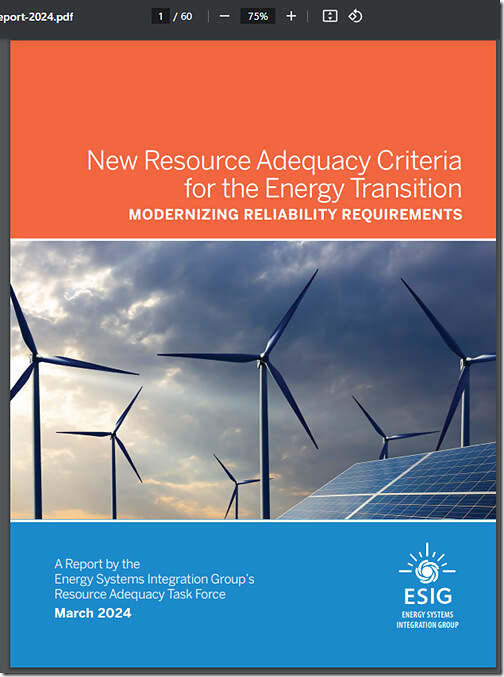Over the past week I became aware of the availability of the ESIG report ‘New Resource Adequacy Criteria for the Energy Transition’ that’s been published this month:
I’ve not done any more than give if a very quick scan, but thought it might be of interest to our readers here on WattClarity®.
The subscribers email I received on Friday 22nd March 2024 about this report noted (with formatting added by me):
‘As we move toward a cleaner and more weather-dependent power system, ensuring resource adequacy becomes more nuanced. It requires a new way of setting resource adequacy thresholds that is responsive to:
Factor 1) the rapid load growth,
Factor 2) plant retirements, and
Factor 3) a shift toward variable and energy-limited resources.
Resource adequacy criteria set the level of supply- and demand-side resources required for a power system to meet its reliability objectives. This standard influences billions of dollars of investment decisions.
The most common resource adequacy criterion today—the one-day-in-10-year loss-of-load expectation (or LOLE) in North America. However, this single metric only measures the frequency of outages and doesn’t capture the size, duration, or timing of generation shortfalls. It also treats longer or widespread outages as equal to shorter, less severe outages. This failure to accurately reflect the real-world nature and impact of power outages, which vary enormously in their economic and human consequences, limits planners’ ability to accurately and efficiently plan a reliable system.
The report explores what it might look like to adopt a multi-metric criteria approach, a framework that would provide a more comprehensive assessment of the size, frequency, and duration of shortfalls; explicitly consider rare, high-impact events such as extreme weather; and stress-test extreme events that may fall outside historical records.
The report also discusses the need for a system’s resource adequacy criteria to establish the appropriate trade-off between reliability and cost. Different options for improving reliability come at different costs, and eliminating all risk in the system is not possible; therefore, as a society, we have to decide how much we will pay for reliability. It is crucial for resource adequacy criteria to capture this intrinsic link between cost and reliability, and for it to be transparent and well understood by all involved.’
The reference to ‘energy-limited resources’ reminds me of how we wrote about ‘The rise of Just-in-Time’ in GenInsights21.
Remember that in the NEM we utilise a probabilistic assessment of % Unserved Energy (USE), which is a different approach to the Loss of Load Expectation noted above that’s used in North America. Despite this difference, what’s in the ESIG report (especially in the light of the 3 Factors) might make for interesting reading in the context of the NEM…



Be the first to comment on "ESIG Report ‘New Resource Adequacy Criteria for the Energy Transition’"